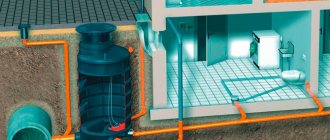Carrying out work to ensure heat supply in apartment buildings
The main regulations that should be relied upon when resolving issues related to the restoration of the heating system:
- Decree of the State Construction Committee of the Russian Federation No. 170 “On approval of the Rules and Standards for the Technical Operation of the Housing Stock” (hereinafter referred to as PG of the Russian Federation No. 170) defines the types of repair work, the rules and regulations for their implementation, the list of works and who carries out them.
- Decree of the Government of the Russian Federation No. 491 (hereinafter referred to as RF PP No. 491) defines the “common property” of MKD. Details the elements to be repaired depending on the degree of wear. Regulates organizational issues.
- The Housing Code (hereinafter referred to as the Housing Code of the Russian Federation) explains the sources of financing for repairs and the features of contractual relations.
In accordance with clause 1.8 of the RF PG N 170, the following types of repairs can be carried out to maintain engineering systems in proper condition:
Let’s determine what their difference is, and what conditions create the prerequisites for each type of repair.
Capital works
Major repairs are a set of measures aimed at eliminating breakdowns of worn-out structural elements of the heating supply of apartment buildings, which are part of the common property. At the same time, work is being carried out to replace or restore them in order to bring them to current operational standards (Article 2 of Federal Law No. 185-FZ).
Prerequisites for carrying out a major overhaul of the heating system:
- development of the service life established by the standards (service life of steel heat supply communications - 25 years);
- a situation arises when individual space heating elements that are in common ownership violate the established maximum permissible reliability characteristics and create a safety hazard (clause 21 of RF PP No. 491).
What is included in the work to restore heat supply during a major overhaul (clause 7.2 STO NOSTROY 2.33.120-2013):
- Complete or partial replacement of intra-house heat supply lines, including risers, branches from risers into the apartment.
- Replacement of control and shut-off valves, including on the branches of risers to heating devices in apartments.
- Replacement of radiators in common areas (entrances, basements).
- Selective replacement of heating radiators in residents' apartments - in the absence of shut-off devices.
The last point of the above list is the most controversial. The fact is that heating radiators, in accordance with clause 6 of RF PP No. 491, are classified as common property, that is, those that serve more than one premises (Article 36 of the RF Housing Code). This means that residents who carry out repairs can theoretically qualify for a free replacement.
In practice, the owner of an apartment during restoration work can try to replace his heating device free of charge only if there are no disconnecting devices on the apartment riser, which will allow the radiator to be recognized as part of the general heating system.
Issues of organizing and carrying out major repairs of the heat supply system in the apartment building are entrusted to the management company. The work can be carried out either by a contractor or with the help of the company’s own personnel with the conclusion of a contract. The latter is more beneficial for residents, as it provides more guarantees against possible quality claims.
Current replacement of elements
It is carried out in a planned manner in order to prevent wear and tear of structural elements related to common property (clause 18 of RF PP No. 491).
The frequency of routine repairs for the heat supply system is not established by law. Repairs are carried out once every few years when deficiencies are identified during scheduled or seasonal inspections and require elimination.
Frequency of central heating inspections:
- scheduled - once a year (Appendix 1 of the RF PG N 170);
- seasonal - 2 times a year: in spring and autumn (clause 13.1 of RF Regulation No. 491).
Legal implementation of this type of repair is possible in two ways:
- The decision on repairs is made by the general meeting of residents on the basis of an inspection report if the residents of the apartment building wish to independently organize the work (clause 14, clause 18 of RF PP No. 491). The contractor is selected by the homeowners.
- Heating restoration work is carried out automatically, without the participation of residents. The contractor is the service organization to which the responsibilities for monitoring the heating network in the house are delegated.
The list of works during routine repairs includes the following measures for the restoration and replacement of individual elements of central heating (clause 11 of appendix 7 of the Russian Federation State Regulation No. 170 and clause 11 of appendix 2 of MDK 2-04.2004):
- Restoration or replacement of individual sections of risers, pipelines, shut-off and control mechanisms.
- Hydraulic testing of the heating system.
- Restoring the integrity of thermal insulation.
- Replacement of individual pumps or electric motors.
- Replacement of individual sections of heating devices.
- Partial replacement of sections of cast iron boilers, fittings, chimneys in the boiler room (if any).
Responsibilities for carrying out routine heating repairs “by default” are assigned to the management organization with which the owners of the apartment buildings have entered into a corresponding agreement (clause 16 of RF PP No. 491).
Troubleshooting
Emergency work on the heat supply system of an apartment building is carried out with the aim of urgently restoring the functionality of the heating system in the event of an accident. In accordance with paragraph 3 of Appendix 1 of MDK 2-04.2004, emergency maintenance of central heating includes the following activities:
- eliminating leaks in pipes, risers, heating radiators by sealing connections;
- repair or replacement of emergency shut-off valves;
- repair of emergency sections of the pipeline by repairing or replacing pipes;
- replacement of emergency pipeline sections up to 2 m long;
- welding work to the extent necessary to eliminate the malfunction.
Emergency faults of pipelines and connections in heat supply systems must be eliminated immediately (Appendix 2 of the RF PG No. 170).
Emergency heating work is included in the housing maintenance fee (Appendix 1 MDK 2-04.2004).
Who performs emergency work:
- during working hours, troubleshooting should be done by plumbers of management companies or housing offices servicing apartment buildings;
- during non-working hours, weekends and holidays - emergency repair services of organizations involved in servicing the housing stock (clause 7.7 of the RF PG No. 170).
Read more: When the cash limit for small businesses was abolished
Residential building power supply rules
- The location for the distribution panel (built-in or mounted) should be convenient, dry, and not prone to flooding.
- The shield should be located no closer than 1 meter from gas and water pipes (PUE - 7.1.28).
- Without waterproofing, it is prohibited to place a shield over a bathhouse, bathroom, or kitchen (PUE - 7.1.29).
- For combustible walls, shields are made fireproof.
- Separate distribution devices can be installed in garages, utility rooms, workshops and for street lighting (PUE - 7.1.22).
- Wiring along the walls (inside and outside) is laid vertically or horizontally, without coming into contact with metal structures.
- Switches are installed 60-140 cm from the floor. When opened, the door does not interfere with access to them. The wire is laid from top to bottom.
- The distance from the floor to the sockets is 50-80 cm. The wire is pulled from the bottom up. One socket per 6 m2 is recommended, not counting the kitchen. There are no sockets in the toilet. The sockets must be at least 50 cm away from heating appliances, gas stoves, and electric sockets.
- Distribution wires and careful insulation are provided for wire connections.
We recommend reading: Logic test when applying for a job
Cost of replacement as part of a major overhaul
The legislation of the Russian Federation places the burden of payment for major repairs of apartment buildings (including replacement of heating) on apartment owners.
Is this included in the payments for major repairs?
Since 2014, residents must transfer funds monthly to a special fund, from which capital repairs are subsequently paid (Article 169 of the Housing Code of the Russian Federation). The amount of contributions for each owner is calculated individually by multiplying the tariff established in the region by the total area of the apartment. The law does not provide for a separate fee for major heating repairs.
Both current and major heating repairs are similar in that they are carried out as planned, but differ in scale and goals. Central heating elements that are in common ownership of the apartment building residents are subject to restoration work. The ultimate goal of the repair is the safe operation of the heating system.
If you find an error, please select a piece of text and press Ctrl+Enter.
A major overhaul of the heating system in an apartment building becomes relevant when there are frequent complaints from residents about the unsatisfactory quality of the services provided, in case of various leaks, or due to the old age of the equipment. Depending on the expected problems, various types of work are performed, the main task of which is to maintain the heating unit in proper condition.
Flushing the heating system in an apartment building
Is a project required to overhaul the power supply of the microdistrict?
Yes, therefore, even without delving into the regulations, you can say that the project will be required. The issue of approving the project with Rostechnadzor most likely will not arise (most likely), but the issue of examination (state examination) of the project is a very pressing issue, and we need to focus on this.
This is interesting: Documents for social security so as not to pay for kindergarten
According to urban planning, design documentation is required. At least to the extent that drawings and diagrams are needed. At least in the form of a working draft. And moreover, commissioning is needed as a separate section of the estimate documentation. And commissioning is confirmed by a measurement protocol from a licensed laboratory. This is ideal. If it’s reconstruction, then there’s also an examination of the design documentation.
Types of repair work of heating systems
Types of heating repairs in an apartment building can be divided into the following categories:
- Maintenance. The main part of the search for problems for this type of work is carried out during routine inspections of equipment in preparation for the heating season. During the period of special audits, minor defects in the system are identified, which are corrected taking into account the technical characteristics of the heating unit;
- major heating repairs are carried out after a certain period of operation of the building and include the dismantling and installation of new components instead of failed units. Here pipes, radiators, valves and other elements of the system can be changed;
- emergency repair. It is carried out urgently and includes work to eliminate emergency situations. This may include measures to eliminate various leaks that may appear as a result of ruptures in riser pipes, elevator plugs, or freezing of a piece of the system.
Preparatory work for the heating season is carried out during the shutdown of the system during the summer break in equipment operation. Water is drained from the structure, which makes it possible to carry out repairs without harm to the residents of the house.
Heating system of an apartment building
What types of repair work are there?
There are three types of repair work on heating systems:
- current,
- capital,
- emergency.
Let's look at each of the presented types in more detail.
Maintenance
Current repair work allows you to identify and eliminate minor faults, carry out routine checks of fittings, their installation and revision. They are carried out once every three to four years and include:
- monitoring the coolant, replacing it if necessary;
- comprehensive flushing of the system;
- inspection of shut-off valves in the elevator heating unit and on risers;
- replacement of risers, elimination of minor leaks in pipes and welds;
- rewinding locknuts on risers;
- valve repair;
- replacing the spacer wedge;
- inspection of cast iron valve;
- regular heating system maintenance.
Find out in more detail what the current renovation of an apartment building is.
Major renovation
Overhaul involves complete or partial replacement of equipment. This activity includes replacement work:
- risers and heating connections;
- heating devices;
- elevator unit or shut-off valves;
- heating spills.
Before drawing up a contract for major repairs, the management company must create a defective list with an indicative list of work and consumables, and then announce a tender for the supply of equipment and repairs.
An agreement is concluded with the winner of the competition indicating the services provided, their cost, payment procedure and other important points.
Find out how major renovations of apartment buildings are carried out.
Emergency repairs
Emergency work is carried out when there is a need to restore the functioning of the heating system after serious damage.
Emergency repairs may be required in the following cases:
- fistula in the heating pipe;
- lack of heating through the riser;
- locknuts in front of the radiator are leaking;
- leakage between sections of heating batteries;
- inability to close the flush valve after flushing;
- defrosting of access heating.
Find out more about what the housing and communal services emergency service does.
Maintenance
In preparation for the heating season, specialists from housing maintenance offices must carry out inspections of heating systems annually. But due to lack of personnel and funding, such events are often simply ignored. As a result, repair work can begin only after a written request from the residents of the house to higher authorities or after receiving a complaint. In the latter case, a commission is created and the following types of heating system repairs are performed:
- checking the operation of the elevator unit of the building and then resetting all valves and gate valves. If necessary, these parts are replaced with new ones. This can also include replacing oil seals and lubrication of rods;
- during the inspection of shut-off valves, worn gaskets are replaced;
- When repairing valves, spacer wedges are restored by grinding in the mirrors, replacing the pressure rings and restoring the rods. Purchasing new valves is not rational, they are very expensive, so this part will be repaired until the last minute.
A cast iron valve by its appearance will never indicate the need for repair, therefore, during routine repairs, the following types of work of a similar plan are carried out:
- checking the locking mechanisms of risers. If these elements are not working properly, then at the slightest damage or leak, it will be necessary to reset the entire house, and this is dangerous during winter frosts and can result in freezing of the system in many areas of the entrance;
- After certain periods of time, it is also necessary to check the fastening of the locknuts. This measure is necessary due to the fading of technical flax, and houses in which sealing was carried out with materials that are not afraid of fading were built in the last century.
But the main work of the team for routine heating repairs in an apartment building is to fully service the system, start it up and eliminate air jams during heating start-up, if residents from the upper apartments cannot do this on their own.
But to avoid bureaucratic delays, contracts are usually concluded between a home maintenance organization and its own repair teams. Workers carry out repairs during personal weekends or vacations. At the same time, the contractors themselves are interested in high-quality performance of the work, because in the event of unsatisfactory repairs, the consequences will have to be eliminated by them. During a major overhaul, the following types of work are performed:
- complete or partial replacement of heating lines or risers;
- complete or selective replacement of heating devices;
- replacement or installation of a new locking part of the elevator unit;
- complete or partial replacement of heating spills.
Replacing a heating battery for current or major repairs
There are several main signs that the heating battery requires replacement or major repairs:
- The heating season is in full swing, and the rooms have become noticeably colder. Sometimes heating devices can heat very weakly or stop working altogether;
- Plaque has appeared in the places where the pipe is attached and at the joints. Its presence can lead to failure of the radiator;
- The radiator has burst or there is a small leak in the heating unit.
Basically, the radiators that are installed in old houses have not been changed since they were installed. In this case, it is better to completely replace them rather than wait until another repair is required. Whatever one may say, modern models are more efficient, and their heat output is much higher. Thanks to this, the room will be comfortable and heating costs will be lower. Among other things, modern versions of heating devices have a more attractive appearance, and therefore fit perfectly into the overall interior of the room.
Emergency repair
The name alone makes it clear that emergency work is carried out in situations where urgent assistance is required. Among the most common problems of this kind are:
- no riser heating. First, the locking mechanisms and valves are inspected; sometimes uncoordinated actions between residents and utility services lead to them simply being closed;
- There is no full water supply to the system. The cause may be an extra object getting into one of the pipes. It could be a piece of rust or slag stuck on a bend in the pipeline. After its elimination, the air is vented from the upper floors, and the system is put into operation;
- leak detection. If there is no threat of destruction, then the brigade’s responsibilities include the task of applying a fastening bandage to eliminate the leak. Next, welding work will be carried out by maintenance specialists.
When the system freezes, the entire riser is turned off and the location of the problem is carefully calculated; after it is detected, the pipe is heated to remove the cause of the malfunction.
Types of repair work of heating systems
Types of heating repairs in an apartment building can be divided into the following categories:
- Maintenance. The main part of the search for problems for this type of work is carried out during routine inspections of equipment in preparation for the heating season. During the period of special audits, minor defects in the system are identified, which are corrected taking into account the technical characteristics of the heating unit;
- major heating repairs are carried out after a certain period of operation of the building and include the dismantling and installation of new components instead of failed units. Here pipes, radiators, valves and other elements of the system can be changed;
- emergency repair. It is carried out urgently and includes work to eliminate emergency situations. This may include measures to eliminate various leaks that may appear as a result of ruptures in riser pipes, elevator plugs, or freezing of a piece of the system.
Preparatory work for the heating season is carried out during the shutdown of the system during the summer break in equipment operation. Water is drained from the structure, which makes it possible to carry out repairs without harm to the residents of the house.
Heating system of an apartment building
Pressure testing of the heating system
Some measures, for example, pressure testing, make it possible to detect malfunctions in a timely manner. First, let's discuss what pressure testing of a heating system is. This term refers to a set of actions aimed at monitoring the condition of heating equipment and its suitability for use.
A hydraulic test is a test of the heating system for leaks.
For this purpose, excess pressure is specially created, which is brought as close as possible to the limit. The latter is determined by calculation. Next, they simulate a water hammer that can occur in the system at any time.
Pressure testing must be carried out:
- upon completion of installation during commissioning of the system;
- after repair of heating devices;
- in case of replacement of part of the pipeline;
- in preparation for the heating season.
It is worth mentioning how pressure testing of a heating system in an apartment building is carried out. This process consists of several stages:
- Filling the system with water.
- An increase in pressure in it.
- Monitoring the indicators of devices that measure pressure.
- Inspect for leaks.
- Troubleshoot if detected.
- Drawing up a certificate of pressure testing.
- Filling the system with water.
Pressure testing is carried out by an enterprise, institution or organization operating the heating system.
Why flush the heating system?
Scale accumulates on the walls of the system, which can cause problems in the operation of the equipment. In particular, it leads to pipe wear and reduced heat transfer. Flushing the heating system in an apartment building is designed to prevent negative consequences.
Due to the slow movement of the coolant, batteries and horizontal sections of pipes become silted over time. Without flushing, the speed of water circulation decreases, and mechanical wear of pipes and fittings, on the contrary, accelerates.
In apartment buildings, flushing is carried out if underheating of individual batteries is detected.
It is important to know not only when to carry out this activity, but also how to properly flush the heating system. Thus, the following conditions must be taken into account:
- For flushing, you can use tap, process or network water;
- the procedure must be carried out until the water becomes clearer and dirt, scale and sludge begin to come out of it;
- in an open system, you should first do a flush, then disinfection and another flush. This is repeated until the water meets drinking standards.
Regulatory documents require this procedure to be carried out annually.
Different washing methods
There are several ways to flush a home heating system:
- Mechanical. Its main purpose is to clean the radiators from dirt and the inner surface of the circuit from scale. Preliminary dismantling of batteries and cleaning of radiators and pipes will increase efficiency.
- Hydrodynamic. To carry out the procedure, you will need special equipment. Water is supplied not from a tap through a hose, but using a high-pressure pump. This allows you to quickly deal with mud and salt deposits.
- Chemical. To avoid mechanical interference, chemical compounds/solutions are used. Dismantling the radiators is not necessary. This method is suitable if you need to restore the functionality of a heating system that has been in use for decades, as well as when it is necessary to remove deposits from steel pipes.
- Hydropneumatic. The essence of this method is to supply air inside the heating circuit under high pressure. This goal is achieved by using a compressor.
- Electrohydropulse. The method is based on the use of electrical impulse energy. It is aimed at destroying salts deposited on the walls of the pipeline. The pipes themselves are not affected in any way.
Maintenance
In preparation for the heating season, specialists from housing maintenance offices must carry out inspections of heating systems annually. But due to lack of personnel and funding, such events are often simply ignored. As a result, repair work can begin only after a written request from the residents of the house to higher authorities or after receiving a complaint. In the latter case, a commission is created and the following types of heating system repairs are performed:
- checking the operation of the elevator unit of the building and then resetting all valves and gate valves. If necessary, these parts are replaced with new ones. This can also include replacing oil seals and lubrication of rods;
- during the inspection of shut-off valves, worn gaskets are replaced;
- When repairing valves, spacer wedges are restored by grinding in the mirrors, replacing the pressure rings and restoring the rods. Purchasing new valves is not rational, they are very expensive, so this part will be repaired until the last minute.
A cast iron valve by its appearance will never indicate the need for repair, therefore, during routine repairs, the following types of work of a similar plan are carried out:
- checking the locking mechanisms of risers. If these elements are not working properly, then at the slightest damage or leak, it will be necessary to reset the entire house, and this is dangerous during winter frosts and can result in freezing of the system in many areas of the entrance;
- After certain periods of time, it is also necessary to check the fastening of the locknuts. This measure is necessary due to the fading of technical flax, and houses in which sealing was carried out with materials that are not afraid of fading were built in the last century.
But the main work of the team for routine heating repairs in an apartment building is to fully service the system, start it up and eliminate air jams during heating start-up, if residents from the upper apartments cannot do this on their own.
Sequence of major repair work
Routine heating repairs involve the following actions:
- Before starting activities, it is necessary to conduct a detailed examination of the condition of the connecting nodes and components of the heating complex. An analysis of the system for the degree of wear will also be required;
- If violations or defects are detected in pipelines, they are eliminated by replacing damaged elements. Eliminating leaks will contribute to safe and reliable operation;
- our specialists will replace or adjust shut-off valves, replace defective pumping equipment and automatic control devices;
- The thermal protection of the pipeline is checked and upgraded in case of a violation;
- Heat exchange parts, batteries and risers are washed. In case of insufficient heat transfer, a comprehensive flushing of the heat supply is carried out. It is advisable to install additional fastening components in order to increase the safety of the equipment.
Regardless of the difficulties with the malfunctions that have arisen, highly qualified technicians are ready to come to anyone who requests the service. Our company contains all the necessary supporting documents giving official permission to carry out such work.
Consequently, the company’s clients can be confident in the professionalism and experience of our specialists.
Major renovation
Before carrying out major work, first of all, a contract is concluded and a statement is drawn up, which sets out guidelines for the necessary materials and costs. Noi contracts are concluded in accordance with a strict procedure:
- The first step is to announce a tender for a more advantageous offer for the supply of materials, works or equipment. All enterprises providing this type of service can take part in the tender;
- after all tender registrations have been completed, contracts are concluded with a full list of future work, costs and guarantees laid out;
- after repairs are completed, depending on the satisfaction of the parties, payment is made or, if the outcome is poor, the case is sent to court.
But to avoid bureaucratic delays, contracts are usually concluded between a home maintenance organization and its own repair teams. Workers carry out repairs during personal weekends or vacations. At the same time, the contractors themselves are interested in high-quality performance of the work, because in the event of unsatisfactory repairs, the consequences will have to be eliminated by them. During a major overhaul, the following types of work are performed:
- complete or partial replacement of heating lines or risers;
- complete or selective replacement of heating devices;
- replacement or installation of a new locking part of the elevator unit;
- complete or partial replacement of heating spills.
Consequences of non-payment
The arguments that paying for major repairs are an optional payment are no longer relevant. The law obliges apartment owners to make contributions.
Otherwise, the debt will grow and penalties will accrue. It is also possible that the debt can be claimed in court. Debts for major repairs deprive the right to receive benefits for utilities.
In addition, if unpaid financial obligations accumulate, the debtor may be prohibited from traveling abroad and may be prohibited from concluding real estate transactions. Other restrictions provided by law are also possible.
Actively participating in the life of the house and fulfilling contribution obligations is the best solution for the owner of an apartment building.
Emergency repair
The name alone makes it clear that emergency work is carried out in situations where urgent assistance is required. Among the most common problems of this kind are:
- no riser heating. First, the locking mechanisms and valves are inspected; sometimes uncoordinated actions between residents and utility services lead to them simply being closed;
- There is no full water supply to the system. The cause may be an extra object getting into one of the pipes. It could be a piece of rust or slag stuck on a bend in the pipeline. After its elimination, the air is vented from the upper floors, and the system is put into operation;
- leak detection. If there is no threat of destruction, then the brigade’s responsibilities include the task of applying a fastening bandage to eliminate the leak. Next, welding work will be carried out by maintenance specialists.
When the system freezes, the entire riser is turned off and the location of the problem is carefully calculated; after it is detected, the pipe is heated to remove the cause of the malfunction.
What applies to major repairs of utility networks?
Thus, the engineering systems of an apartment building include:
- Overhaul of water supply and wastewater systems.
- Heating system. Most apartments have traditional radiators, which heat up when stable low temperatures arrive.
- Sewerage.
- Electricity.
- Ventilation system.
- Elevator system.
- Low-current networks, thanks to which it becomes possible to use the Internet, television, etc.
However, in order for all engineering systems to function in the correct mode, i.e. without failures, it is necessary to carry out certain work aimed at maintaining the condition of the vital systems of an apartment building.
Some of them are carried out on a regular basis and are ongoing, while some work is classified as capital. For example, a major overhaul of electrical wiring in an apartment building is being carried out. To make it clearer, let’s look at this classification in more detail.
This video is unavailable
It turns out that the entire package of documents testified to the alleged major repairs of the apartment building No. 154 on the embankment. can. Griboyedov in St. Petersburg and, according to the Administration of St. Petersburg, was destroyed many years ago, was in the prosecutor's office of St. Petersburg and was provided to Alexander for review on February 25, 2014, on the third day of familiarization with the materials of supervisory proceedings 7-3177-2011 on appeals addressed to the prosecutor of St. Petersburg Litvinenko Sergei Ivanovich.
One of the main problems that Alexander Skurkis brings to the attention of the authorities and the public is the situation related not only to the large-scale falsification by current officials of the Administration of St. Petersburg of the election of management companies in the Admiralteysky district of the city, but also to the conduct by them, officials and commercial structures affiliated with them in the housing and communal services sector, supposedly “major repairs” of apartment buildings. This topic is now relevant for the entire population of Russia, because in the coming years the cost of “major repairs” is going to be imposed on homeowners.
This is interesting: Certificate of pension assignment
Current and major work in an apartment building
First, let's figure out what is the current repair of engineering systems, and what is a major one? Based on this, their difference from each other will be clearer, which is very important for understanding the issue itself.
Current repairs of engineering systems are carried out as planned, the purpose of which is to restore operability, partially restore their service life, which is expressed in the replacement or repair of certain components, which are expressly stated in the relevant regulations.
Such work is aimed at preventing wear, i.e. are in some way preventative.
Current work includes foundation repairs. This list includes: sealing seams and cracks, replacing foundation and wall cladding, repairing ventilation systems, etc., walls, roofs, replacing floor waterproofing, etc.
In a word, the current work is more like a cosmetic renovation, when the appearance of the building and entrance is partially restored.
The thing is that a major overhaul of the engineering systems of an apartment building means a complete replacement of these systems, each of which has its own operational life, after which major work must be carried out. In this case, the work will be carried out in the same areas as the current ones, but with a complete replacement of the main systems...
Where can I find information?
Data on types of repairs (current and major) are contained in legislative documents:
- The Housing Code of the Russian Federation briefly lists the types of services related to major repairs;
- The Decree of the State Construction Committee dated September 27, 2003 contains a detailed list of major and current repairs of facilities;
- Methodological manual MDK 2-04.2004 contains standards for current and major repairs and the most comprehensive list of work carried out in the event of malfunctions of general building systems.
Let us remind you that we previously covered in detail the process of applying for benefits for major repairs.
Frequency
As mentioned earlier, each engineering system of an apartment building has its own service life. This information is clearly displayed in the technical regulations, which read as follows:
- Central heating system - 25 years.
- Replacement of hot water supply risers during major repairs - 30 years (if the risers are not galvanized, then 15 years).
- Cold water supply risers - 30 years (if the pipes are not galvanized, then 15 years).
- Overhaul of the power supply system - 20 years.
- Sewerage - 60 years (if the pipes are ceramic or plastic) and 40 years (if the pipes are cast iron).
- Roofing - depending on the material. Accordingly, a roof made of slate lasts 30 years, one made of galvanized steel - 15 years, and one made of rolled materials - about 10 years.
The above figures are the wear and tear of the main engineering systems of the building. Accordingly, capital work must be carried out after this period, including a complete replacement of the structural components of each system.
Forum for electricians, installers, power engineers, designers
The house is planning a major overhaul of the electrical system. The project provides for the replacement of ASU, replacement of floor panels, replacement of automatic switches, replacement of inputs into apartments up to the apartment control panel. Nothing changes in the apartment itself, i.e. the two-wire system remains. And the question arose: is it necessary to switch from TN-C to TN-CS with the division of the PEN conductor into PE and N in the ASU or should the TN-C system remain. Thank you in advance.
The house is planning a major overhaul of the electrical system. The project provides for the replacement of ASU, replacement of floor panels, replacement of automatic switches, replacement of inputs into apartments up to the apartment control panel. Nothing changes in the apartment itself, i.e. the two-wire system remains. And the question arose: is it necessary to switch from TN-C to TN-CS with the division of the PEN conductor into PE and N in the ASU or should the TN-C system remain. Thank you in advance.
This is interesting: How many days can I stay on sick leave with a child?
How to request ahead of time?
According to the regulations, major repairs of a building's engineering systems, for example, major repairs of a pipeline, can be carried out ahead of schedule only if a real threat to the life and health of the residents of a particular building is proven.
To make this possible, changes need to be made to the regional program, i.e. local government bodies, management organizations or homeowners' associations must submit an application to the relevant executive authority that deals with this issue.
Naturally, the decision to carry out major repairs earlier will be made only after a series of inspections and examinations of the condition of the building.
It is worth noting that to request repair of engineering systems you need to write a statement. It is designed in a free style according to the generally accepted pattern.
When starting to write an application, you should start by drawing up a header, which states to whom the application is being sent (position, company name), followed by the surname, first name and patronymic of the manager, the applicant’s initials, address and contact telephone number).
The body of the application states the essence of the problem (for example, a major overhaul of heating networks is required), indicates when the last inspection was carried out, and adds descriptions of the condition of engineering systems. This is followed by the date and signature of the applicant.
As a rule, you have to wait 10 working days for a response from the management company, which is REU, ZhEK or REMP.







